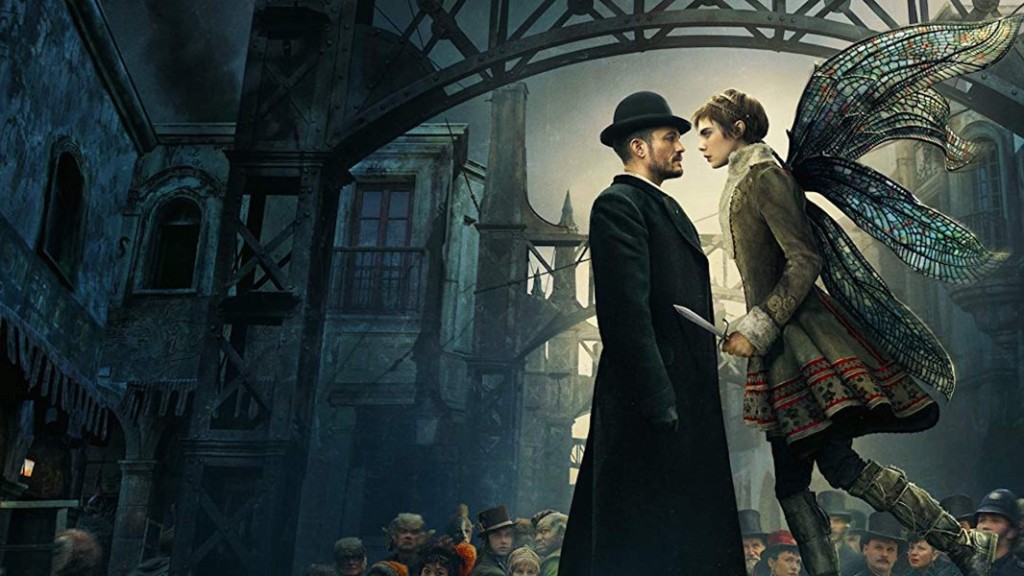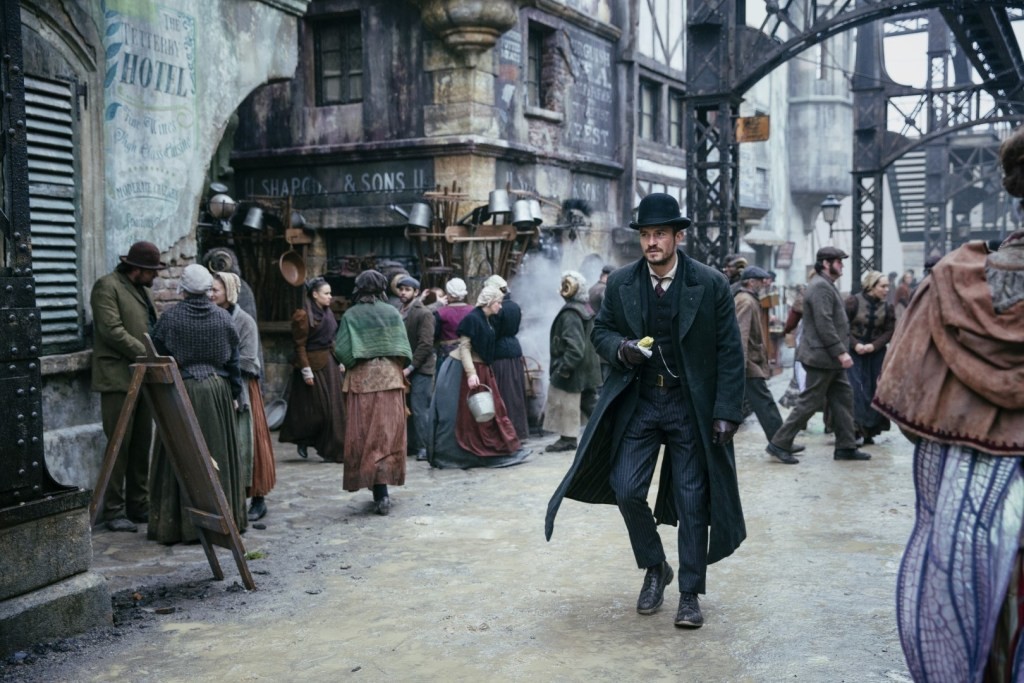Genre: Period/Fantasy
Premise: A detective reunites with the fairy he abandoned while investigating the most notorious serial killer Carnival Row has ever seen.
About: Once thought of as the best unproduced screenplay in Hollywood, Killing on Carnival Row has had a series of suitors come onto the project, only to leave after finding it impossible to produce. It was going to take an extraordinary budget to realize the mythology at the center of Carnival Row and without any superheroes or even familiar characters executives could sell to their studio heads (“Can’t we just throw Robin Hood in there or something?”), the project kept running into brick walls. Enter Amazon Prime and their giant forest of money. 14 years after Travis Beacham wrote the script, it debuted this weekend on the streamer.
Creator: Travis Beacham & René Echevarria
Details: First Episode is 60 minutes long
If there ever was a project that exemplified the struggle of getting something made in Hollywood, it would be Carnival Row. Just to give you some perspective on how difficult it was to get this made, the model by which it finally got produced didn’t even exist when the script was written. Nobody was making 150 million dollar TV shows back in 2006.
So the question has to be asked: How did this get made? And can we learn anything from it that will help us hawk our own projects? I can answer that easily. 99% of every movie or TV show you’ve seen has been the result of someone SO PASSIONATE about their project that they refused to take no for an answer. This is how you get stuff made. In a system so wacky every studio in town turned down Back to the Freaking Future, you can expect more no’s pitching a movie/show than you’ve ever heard in your life.
Remember, you’re asking people to put forward tens, sometimes hundreds, of millions of dollars to see your project realized. This for something that’s a complete gamble! That model requires a dedicated passion that few people are capable of exerting over a long period of time.
But there’s a second part to this answer. The script actually hast to be good. Carnvial Row spent 5-6 years as the unofficial top script in Hollywood. It wasn’t like Beacham was running around with a watered down first draft of something called, “Ned’s Basement.” The script had earned a reputation which is why people kept jumping onto it. It’s an important distinction because I don’t want anyone pushing Ned’s Basement thinking, “Well Carson said that passion is all I need!” There has to be some feedback that indicates you possess something of value.
Due to the project’s backstory, I wasn’t watching Carnival Row like the average viewer was. I was taking into account ten years of history on the project. How was it going to end? Would it be as game-changing as the script? Or would it be a cautionary tale, a compromised glorified piece of Hollywood fluff? And what about the change to television? Was that a good idea? I invite you to find out.
Our opening teaser thrusts us into a mass fairy hunt through the forest. You may be wondering why our fairies don’t just fly away from their pursuers. That’s because a giant barbed wire ceiling has been laced throughout the forest preventing this very action. Only a single fairy, Vignette, is able to escape, leaping off a cliff at the end of the forest and flying to a nearby ship.
We then cut to “The Burgh,” which can best be described as 18th century London except with fairy prostitutes and human-ram hybrids. A young rich woman, Imogen, is excited when she learns that a hot rich gentleman will be moving in across the way. Nearby, Detective Philostrate is walking the streets looking for a serial killer who’s murdering fairies.
After the ship Vignette escaped to is attacked and sinks, she floats up on shore, the only survivor from the ship (man is this girl lucky!). The owner of the ship, Ezra, is informed of its fate, but given a consolation prize. Vignette, the lone survivor, is technically his! So he adopts her as a servant in his household, which we learn is also his sister, Imogen’s, place.
Vignette is no stranger to the Burgh. She used to live on Carnival Row, the seedy underbelly of the city, making a living as a prostitute. So she heads back to see some old friends and learns that the love of her life, Detective Philostrate, is still alive. This is a big deal since the only reason she left this hellhole was because she was told he was dead. Vignette doesn’t waste any time, charging through the Row to find and confront Philostrate. When she finally locates him, he admits that he fed someone the lie to end their relationship. And you thought getting dumped by text was bad.
Their situation is left unresolved because we need to see yet another poor fairy get murdered by the Carnival Row serial killer. We conclude the episode with the shadowy figure pulling the screaming girl into his subway cave.
So how was it? Worth the wait?
I’ll say this. TV is the better format for this show. This isn’t a singular experience. It’s a world. And when you have a world – at least these days – you want a TV show. So on that end, they made the right call.
But the adaptation of a feature script into a TV series is a difficult one. The primary alteration is that in movies you usually focus on a single hero. Sure, there are other characters, but we’re seeing them all through our hero’s eyes. Once you make the move to television, you can’t do that anymore. No character is interesting enough to be the focus of every single scene for 100 hours.
So what you have to do is create a BUNCH of heroes. Every character, all of a sudden, needs to have their own storyline, their own journey. This is challenging because creating even a single strong character is hard. Now you’ve got to create 10 of them. But if you’ve ever had trouble with character in your screenwriting journey, you should write a TV show just for practice. You’ll be surprised at how much you learn about the people in your story when you’re writing scenes just or them.
The distilled character concentration helps Carnival Row in some ways and hurts it in others. If I remember correctly, Vignette wasn’t that developed in the feature script. But now, with all this extra time, they can give her an entire backstory. This led to one of my favorite scenes, the teaser, where the fairies are getting chased through the forest. I’ve read hundreds of forest chase scenes. But I’ve near read one where fairies are running and “locked into” a ground chase because barbed wire is being used as a ceiling to keep them from flying. The horrid sight of numerous dead fairies who’d tried to fly off in the past only to get caught – their corpses now rotting on the wires – was a memorable image.
But in introducing all of these new characters and their storylines, the hero, Philostrate, gets way less screen time than he did in the feature script, where his pursuit drove the entire story. In fact, he gets so little screen time that it took me a few scenes with him before I realized he was looking for a serial killer. If there’s a knock on this pilot, it would be that the stakes feel low. And that’s likely because Philostrate’s pursuit didn’t feel that important.
Not to mention, the pilot opens with that mass fairy killing scene. If we just watched a hundred fairies gets slaughtered, a fairy serial killer who’s got 5 kills under his belt doesn’t seem like the biggest problem anymore. This is one of things you have to be aware of when adapting features into TV shows. You have to make sure the added plot doesn’t neuter the storylines that made the feature so great. It can be hard to keep track of that when you’re so deep inside your world.
Now maybe this is remedied in future episodes where the serial killer plotline becomes more prominent or an even bigger plotline is introduced that drives the story. But I wouldn’t have gone that route if I were them. I know every creator these days assumes their shows will be binged like movies but bingers are still a small percentage of the TV audience. Most people have busy lives and lots of choices for their entertainment. If they’re not pulled in by that first episode, they’re not going to click on the next one (despite Amazon’s lightning fast efforts to get you to do so – no more than three seconds after the pilot was over, a new episode began!).
My gut reaction to this pilot is that I liked it. The realization of this world, outside of a couple minor issues (the $2 ram helmet that ram characters are forced to wear being the most egregious) is as strong as it was in Beacham’s script. But the only question that matters when it comes to pilots is, “Will I watch another one?” I go back and forth on it. Maybe? Like I said, the stakes feel low. And that hurts in a show like this, where the exemplary production value implies a Game of Thrones or Lord of the Rings like set of stakes.
What did you think?
Original Script Link: Killing on Carnival Row
[ ] What the hell did I just watch?
[ ] wasn’t for me
[x] worth the stream
[ ] impressive
[ ] genius
What I learned: Whereas you might be able to get away with not writing character bios for a feature, you ABSOLUTELY HAVE TO WRITE THEM for a TV show. Every character needs AT LEAST a two page biography. But I would encourage you to write as many as five pages. Take two weeks before you write your pilot and spend two days writing out each character biography in as much detail as possible. Trust me on this. You will know your characters a million times better, which will in turn make them a lot more interesting on the page.



